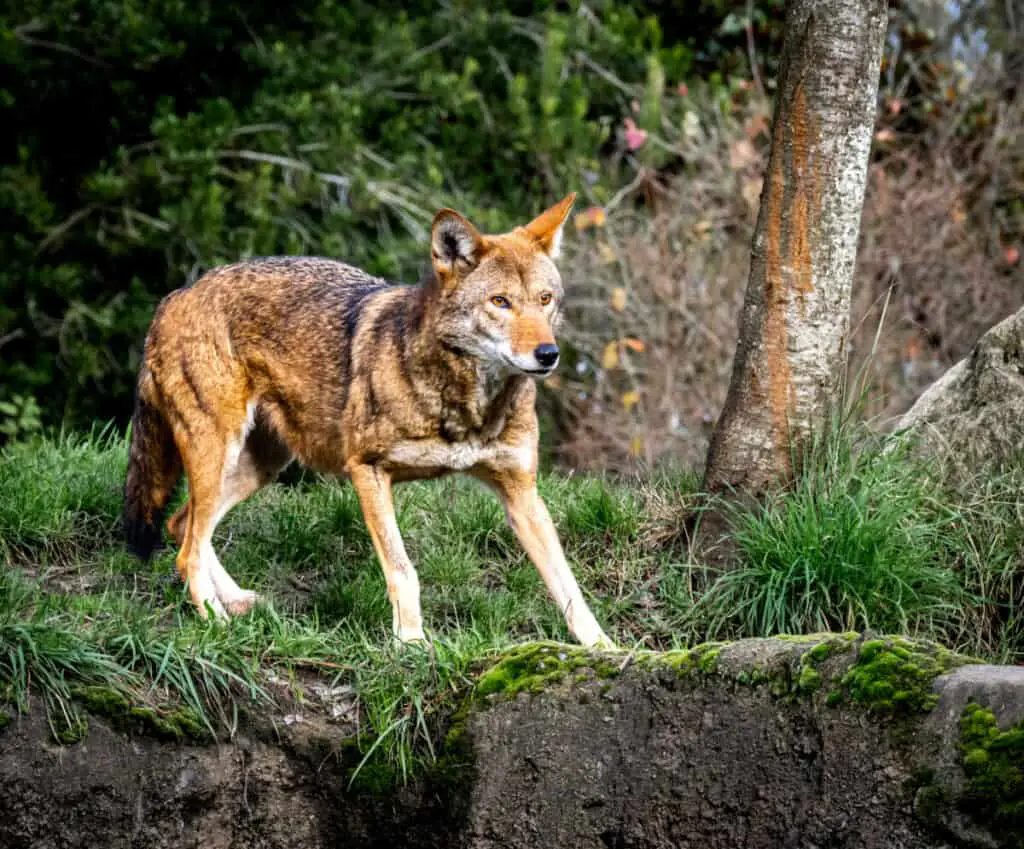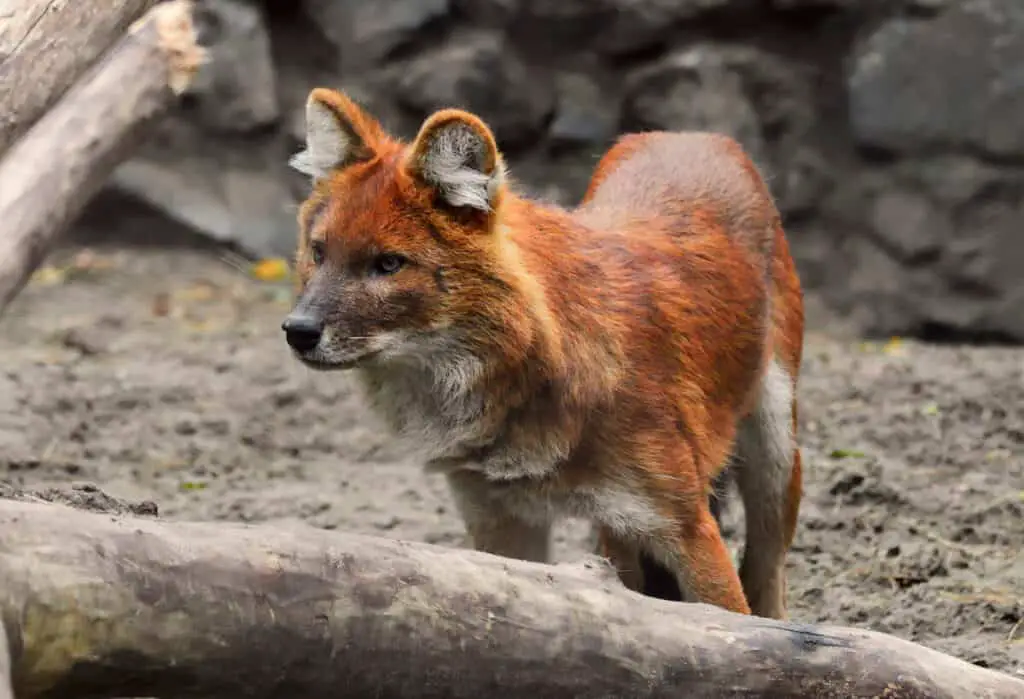The Red Wolf (Canis rufus) is a critically endangered species that once roamed the southeastern United States. Once considered extinct in the wild, it was later reintroduced into its historic range through captive breeding programs and recovery efforts.
Despite these efforts, the population remains perilously low with less than 30 individuals remaining in the wild.
Red Wolves are smaller than their gray wolf counterparts, weighing between 45-80 pounds and standing at around two feet tall at the shoulder. They are distinguishable by their reddish-brown coat and black-tipped tail.
Historically, they inhabited much of the Southeastern United States including Texas to Pennsylvania. Today, however, their habitat is limited to only one region in eastern North Carolina where they face ongoing threats from habitat loss due to human development and hybridization with coyotes.
As such, conservationists have been working tirelessly for decades to save this iconic American predator from extinction.

Historical Range And Distribution
The red wolf is a critically endangered species native to the southeastern region of North America. Historically, their range extended from Texas and Florida in the south up to Pennsylvania in the north. They were also found along the Gulf Coast, as far west as Louisiana, before human intervention caused significant declines in their population.
Red wolves have played an important ecological role throughout their historic range by helping control populations of small prey such as raccoons and rabbits. Additionally, they are culturally significant to many Native American tribes in the southeast United States who consider them sacred animals with spiritual significance.
Despite this cultural importance and ecological impact, habitat loss, hunting, and hybridization with coyotes have pushed red wolves near extinction.
Physical Characteristics And Behavior
The red wolf is a medium-sized canid, weighing between 45 to 80 pounds with a length of about four feet. It has reddish-brown fur with black-tipped hairs on its back, ears, and legs. Its long snout distinguishes it from other wolves in the region.
Red wolves are primarily nocturnal animals that prefer dense forests or swamps as their habitat.
Hunting behavior is an essential aspect of the red wolf’s behavior. They hunt alone or in small groups for small prey such as rabbits, rats, and deer. The pack usually cooperates during hunting larger prey like white-tailed deer and wild boar.
Their social structure is similar to that of gray wolves; they live in packs consisting of breeding pairs and their offspring from previous litters. In general, male red wolves tend to roam more than females, but both sexes participate equally in raising pups.
Status As A Critically Endangered Species
The physical characteristics and behavior of the red wolf are fascinating, but unfortunately, this species faces numerous conservation challenges.
The International Union for Conservation of Nature (IUCN) lists the red wolf as critically endangered due to its significant population decline over the last few decades.
According to recent estimates, there are only approximately 24-26 known wild red wolves remaining in their native range in eastern North Carolina.
This drastic decline can be attributed to various factors such as habitat loss, hybridization with coyotes, and human persecution.
Conservation efforts have been ongoing since the mid-1970s when a captive breeding program was initiated to save the dwindling population.
Despite these efforts, reintroduction attempts faced difficulties due to opposition from landowners and political pressure.
The situation is dire for red wolves today, and urgent action is needed to prevent them from going extinct.
Reintroduction Efforts And Captive Breeding Programs
Reintroduction efforts and captive breeding programs have been implemented to increase the population of red wolves in the wild. However, these initiatives face numerous challenges that need to be addressed for their success.
One major problem is the difficulty of reintroducing a species into an ecosystem where it has not existed for decades. Red wolves may struggle to adapt to new environments and compete with other predators in the area.
Moreover, genetic diversity in captive populations presents another challenge. Since red wolf numbers dwindled significantly in the 20th century, there are limited individuals available for breeding purposes. Inbreeding increases the risk of genetic disorders and reduces overall fitness levels, which can hinder successful reintroduction efforts.
To overcome this issue, various organizations work towards creating genetically diverse captive populations by exchanging animals between different facilities across the country or artificially inseminating females using frozen semen from unrelated males.
With proper planning and execution, reintroduction efforts and captive breeding programs hold promise for saving the endangered red wolf population from extinction.
Ongoing Threats To Survival
Ongoing Threats to Survival of the red wolf include hunting regulations and habitat loss. The regulation of hunting is an integral part of wildlife conservation efforts, but it can also pose a threat if not properly implemented.
Red wolves were once hunted extensively for their fur, which led to their near-extinction. In 1967, they were listed as endangered under the Endangered Species Preservation Act, and in 1973, they were protected under the Endangered Species Act. Despite these measures, illegal hunting still occurs today, with some individuals killing red wolves out of fear or misunderstanding. This highlights the need for effective enforcement and education programs that promote coexistence between humans and red wolves.
Habitat loss is another major factor affecting the survival of red wolves. As human populations expand, natural habitats are destroyed or fragmented, limiting the space available for species such as the red wolf. This makes them more vulnerable to environmental stressors such as disease outbreaks and competition with other predators.
Conservation efforts must focus on addressing these ongoing threats to ensure the long-term survival of this magnificent species. Implementing sustainable hunting practices and protecting crucial habitats through land-use planning and restoration projects will be essential in achieving this goal. It is imperative that we continue to work towards preserving our planet’s biodiversity so that future generations may enjoy its wonders too.

Conservation And Recovery Efforts
Conservation and recovery efforts have been underway for the red wolf since it was listed as an endangered species in 1967. Over the years, various strategies have been implemented to protect and restore this iconic animal’s population.
One of the key approaches has been through collaborative partnerships between government agencies, conservation organizations, private landowners, and academic institutions. These partnerships aim to address habitat loss, reduction of prey populations, human-caused mortality, and genetic diversity issues affecting the wolves.
Additionally, public awareness campaigns have played a significant role in raising support for these initiatives. The public is encouraged to participate in activities such as citizen science programs or volunteering at wildlife rehabilitation centers that help conserve these apex predators’ habitats.
Overall, with continued collaborative efforts from stakeholders across different sectors combined with effective communication strategies like public awareness campaigns can ensure lasting success towards conserving and recovering the red wolf population.
Strategies for Red Wolf Conservation:
- Habitat restoration
- Reduction of human-induced mortality
- Genetic diversity management
- Implementation of effective communication and public awareness campaigns.
Conclusion
The red wolf, once an abundant predator in the southeastern United States, has seen a significant decline in population over the years. Historical records suggest that its range spanned from Texas to Florida and as far north as Virginia. The species is characterized by its reddish-brown fur and black-tipped tail, with a social behavior that includes living in packs.
Today, the red wolf is considered critically endangered due to habitat loss, hybridization with coyotes, disease outbreaks, and human persecution. Despite conservation efforts through reintroduction programs and captive breeding initiatives, populations continue to struggle. Nevertheless, dedicated individuals and organizations are working tirelessly towards ensuring the survival of this magnificent species for future generations.
In conclusion, it is imperative that we recognize the importance of preserving our natural heritage while acknowledging the challenges faced by conservationists. Through concerted efforts to protect remaining habitats and support ongoing recovery programs such as captive breeding initiatives and reintroduction schemes, we can ensure that these majestic creatures thrive once more within their historical ranges.
With continued dedication and perseverance towards conserving biodiversity hotspots like that of the red wolf’s range area will help preserve it for posterity.

